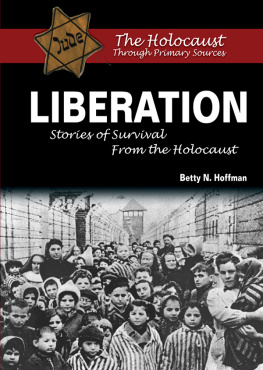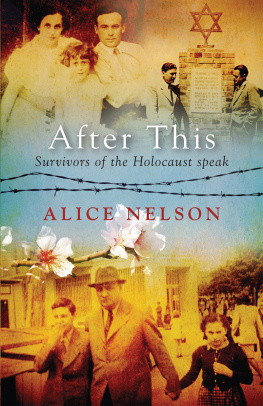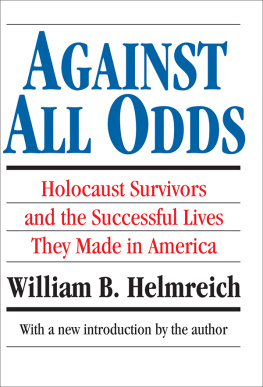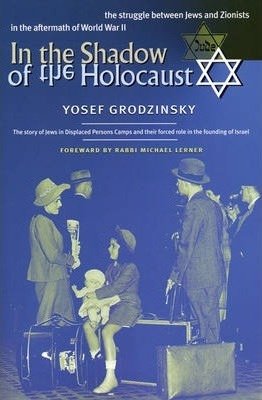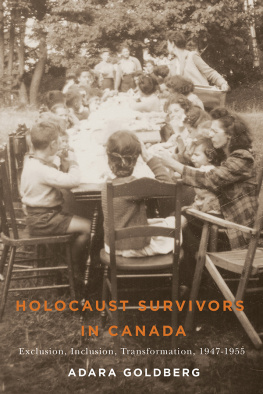This book is a publication of
Indiana University Press
Office of Scholarly Publishing
Herman B Wells Library 350
1320 East 10th Street
Bloomington, Indiana 47405 USA
iupress.indiana.edu
Publications of the Goldstein-Goren Diaspora Research Center

Book 193
The preparation and publication of this volume has been made possible by a grant from the Conference on Jewish Material Claims Against Germany, and by a grant from the Memorial Foundation for Jewish Culture.
2018 by Franoise S. Ouzan
All rights reserved
No part of this book may be reproduced or utilized in any form or by any means, electronic or mechanical, including photocopying and recording, or by any information storage and retrieval system, without permission in writing from the publisher.
The paper used in this publication meets the minimum requirements of the American National Standard for Information SciencesPermanence of Paper for Printed Library Materials, ANSI Z39.48-1992.
Manufactured in the United States of America
Library of Congress Cataloging-in-Publication Data
Names: Ouzan, Franoise, author.
Title: How young Holocaust survivors rebuilt their lives : France, the United States, and Israel / Francoise S. Ouzan.
Description: Bloomington, Indiana : Indiana University Press, [2018] | Series: Publications of the Goldstein-Goren Diaspora Research Center ; Book 193 | Series: Studies in antisemitism | Includes bibliographical references and index.
Identifiers: LCCN 2018000245 (print) | LCCN 2017060875 (ebook) | ISBN 9780253034557 (e-book) | ISBN 9780253033130 (hardback : alk. paper) | ISBN 9780253033956 (pbk. : alk. paper)
Subjects: LCSH: Jewish children in the HolocaustInterviews. | Holocaust survivorsRehabilitationFrance. | Holocaust survivorsRehabilitationUnited States. | Holocaust survivorsRehabilitationIsrael. | Holocaust, Jewish (1939-1945)Influence. | JewsHistory1945-
Classification: LCC D804.48 (print) | LCC D804.48 .O99 2018 (ebook) | DDC 940.53/180922dc23
LC record available at https://lccn.loc.gov/2018000245
1 2 3 4 523 22 21 20 19 18
ACKNOWLEDGMENTS
IT IS MY pleasure to acknowledge my indebtedness to the many people who have aided my research for this book. I wish to thank the survivors, women and men, who generously shared their time and experiences with me. I want to make special mention of the fact that while I could not use all their testimonies for lack of space in this volume, I greatly profited from the insights provided by their narratives.
Researchers or authors often acknowledge a mentor who inspired them along their path. I am fortunate to have been guided by many, and the few handwritten letters I received from Elie Wiesel were golden pebbles that brightened my route. I also cherish the memory of an inspiring conversation with Simone Veil when she came to Jerusalem in June 2008. Samuel Pisar always made himself available to answer my endless questions, over the phone or in his home in Paris. After he passed away, his wife Judith and daughter Leah extended the same generosity. Numerous interviews with my friend Paula Neuman Gris, whom I met in Atlanta in the 1990s, led me to better understand the postwar experience of refugees and their daily humiliations.
The former Buchenwald boys, whom I traced in France and in Israel with the help of Judith Hemmendinger, who had directed one of the Oeuvre de secours aux enfants (OSE; Childrens Relief Agency) homes in France, patiently illuminated for me various facets of their life experiences and challenges both before and after the war.
The embryo of this book originated as far back as 1993 when, at the Sorbonne in Paris, I defended my doctoral dissertation on the immigration of displaced persons (DPs) to the United States during the Truman presidency. The inquisitive professors on the committee all have a share in this present work. Historian Yosef Gorny of Tel Aviv University, a survivor from Poland who came to Israel as a young adolescent, went a step further and let me benefit from his knowledge. This book would not exist without the multifaceted portraits of the Shoah survivors who trusted me, risking again the resurgence of traumatic memories. They all believed that the mission of transmission to future generationsto which they were deeply committedwas worth the risk. I learned much from their staunch optimism, humor, and warmth.
In 2002, I was glad to find a nurturing environment at the Centre de Recherche Franais de Jrusalem (CRFJ, MAEE), a branch of the CNRS, the French National Center for Scientific Research. I take this opportunity to thank the University of Reims Champagne-Ardennes, where I was an associate professor before becoming a full-time researcher. Dominique Bourel, who welcomed me at the French Research Center in Jerusalem, did not miss a chance to direct me to any survivor he had met. The support of the CRFJ staff cannot be overstated. To name but a few: Florence Heymann, Eva Telkes-Klein, and Lyse Baer, who dealt with the red tape of each international conference on survivors or postwar migration that we organized together.
I later found another home in the Goldstein-Goren Diaspora Research Center at Tel Aviv University, where I was first welcomed by its former head, Jeremy Cohen (who was the first to believe in my research), followed by its current director, Simha Goldin, himself a son of Holocaust survivors, and all the staff; Ora Azta, who dealt with all types of bureaucracy; Sara Appel, who supported me with her editorial guidance; and my colleagues and friends Lylya Belenkaya, Yoram Erder, Robert Rockaway, Dror Segev, Naomi Feuchtwanger-Sarig, Aviva Rosenthal, Galit Haddad, Aviva Mezrahi, Maya Guez, Anat Shimoni, Netta Ziv-Av, Adi Moscovitz, and Ruthi Vygodski, who all surrounded me with cheerful support. This also applies to Sofia Tels-Abramov, the helpful director of the Mehlmann library and archives. Dina Porat, the chief historian of Yad Vashem, was instrumental in encouraging me along the way, together with Dalia Ofer at the Hebrew University in Jerusalem, and Hanna Yablonka at Ben-Gurion University. I am also grateful to Dan Michman, Jonathan Sarna, and Atina Grossmann for expressing their immediate enthusiasm about the importance of the book and to David Weinberg, Jean-Marc Dreyfus, Sergio DellaPergola, Andr Kaspi, Manfred Gerstenfeld, and Benjamin Balint for providing encouragement. As I completed this volume, my friend Dalia Rosenfeld kept my spirits high with her wry sense of humor, as she had just published her own book. In Paris, friendly conversations with my colleagues Annette Wieviorka and Anny Dayan Rosenman resulted in more inspiring (although barely legible) notes on my manuscript.


